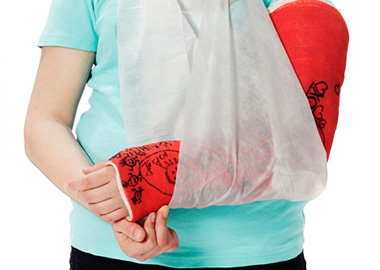Intro
Reporting Requirements
Types
Talking to
a Youth
Making the
Report
Conclusion
Physical Abuse
Define
Recognize
Practice
Listen to audio
Physical abuse is defined as physical injury inflicted on a youth by other than accidental means. The statutes define physical injury as anything from severe or frequent bruising to more serious injuries.
That’s the definition. Now we are going to look at physical abuse more closely to understand what it means.
 You will note that this definition says nothing about who might be inflicting the injury. That is intentional. Physical abuse is not restricted to injury inflicted by parents or other caregivers.
You will note that this definition says nothing about who might be inflicting the injury. That is intentional. Physical abuse is not restricted to injury inflicted by parents or other caregivers.
Physical abuse can be committed by any person, even a person who has no responsibility for the youth, and it can even be committed by another youth.
In a facility setting, you should keep in mind that physical abuse that is committed by another youth may also indicate lack of supervision (neglect) on the part of the facility.
Yes. Physical abuse includes only non-accidental injuries. Injuries that are purely accidental are not abuse. Non-accidental injuries fall into one of the following categories:
- The suspected maltreater intended to cause injury to the youth.
For example: A staff member at a group home punches a youth who is talking back to him.
- The suspected maltreater knowingly, carelessly or recklessly engaged in behavior that was dangerous to the youth and resulted in injuries, regardless of whether he or she intended to cause the injuries.
For example: A correctional officer pushes a youth who is refusing to return to her room and she falls and hits her head.
No. Even youth with minor injuries, such as a small bruise, have access to protection under the law if those minor injuries may be an indication that the youth is in danger. Remember that the child protection system also responds to threatened abuse or neglect. Check the threatened maltreatment section for more information.
 Here are four examples:
Here are four examples:
- A correctional officer properly (pursuant to his training) performs a physical restraint on a youth who had become out of control and the youth does not have any physical injuries resulting from the restraint.
- A counselor at a residential care facility is hit by a youth and when she holds up her arms to shield herself the youth falls down and sustains minor injuries.
- A youth returning from visitation time with his family discloses that his mother had spanked him but that the spanking had not left a mark.
- Two youths had to be separated after starting to fight with each other, and neither suffered any injuries due to the fight other than scraped knuckles and minor bruising to their hands.
TIP: Don’t worry about whether the injury might be serious enough to meet the definition of physical abuse. That’s hard for a reporter to tell, and is something that CPS or law enforcement can determine.
Physical Abuse Scenarios

1) You are a counselor at a group home. 14-year-old Amara comes to you for her weekly appointment and you notice that she has a cast and sling on her arm. You ask her how the injury occurred, and she tells you that she was playing basketball with other kids at the group home and accidentally slammed her arm when she fell after jumping to shoot a basket. You ask the staff member who was supervising the basketball game and she tells you the same story and reports that Amara was immediately brought to an area hospital and treated for a broken arm.
Are you required to report?
Correct: The injury is completely consistent with the explanation from both Amara and the staff member, and there is no reason to doubt their explanation. The injury is accidental in cause and the staff member in charge properly obtained immediate medical attention for the youth.
Incorrect: You are not required to report.
The injury is completely consistent with the explanation from both Amara and the staff member, and there is no reason to doubt their explanation. The injury is accidental in cause and the staff member in charge properly obtained immediate medical attention for the youth.

2) You are walking by a unit in the detention facility where you work and you witness a verbal altercation between 16-year-old Andy and 15-year-old Alvin. Before you are able to reach them Alvin shoves Andy as hard as he can and Andy hits his head against the wall, sustaining a fairly deep laceration to the skull.
Are you required to report?
Correct: You are required to report.
Andy has sustained a severe injury, and it was not accidental in cause, even though Alvin did not necessarily intend to cause the injury. A reasonable person would conclude that shoving someone very hard can result in injuries. It does not matter that Alvin is a minor and is not Andy’s caregiver – the definition of physical abuse for reporting purposes includes any person who perpetrates the abuse.
Incorrect: You are required to report.
Andy has sustained a severe injury, and it was not accidental in cause, even though Alvin did not necessarily intend to cause the injury. A reasonable person would conclude that shoving someone very hard can result in injuries. It does not matter that Alvin is a minor and is not Andy’s caregiver – the definition of physical abuse for reporting purposes includes any person who perpetrates the abuse.

3) Your colleague is conducting a restraint on 17-year-old Chou who was trying to punch and kick other youth and staff and could not be de-escalated through other means. During the restraint, your colleague violates protocol by jamming his knee into the youth’s stomach and then holding him down in a position where he can’t breathe until you tell him to stop. Afterwards, you notice that Chou is clutching his stomach where your colleague’s knee was and that he is having trouble breathing.
Are you required to report?
Correct: You are required to report.
Even though you are not in a position to actually see injuries, there is reason to suspect that Chou might have sustained injuries. The injuries cannot be considered accidental, as a reasonable person would conclude upon witnessing a colleague’s behavior toward Chou that it could result in injuries.
Incorrect: You are required to report.
Even though you are not in a position to actually see injuries, there is reason to suspect that Chou might have sustained injuries. The injuries cannot be considered accidental, as a reasonable person would conclude upon witnessing a colleague’s behavior toward Chou that it could result in injuries.

4) You are conducting intake and notice that 15-year-old James is upset about something. When you ask him what’s wrong, he tells you that his dad gave him “a whoopin’” last night. You ask him what “a whoopin’” is, and he says that’s when his dad hits him for being bad. When you ask, he says he was hit on his butt. He reported that it doesn’t hurt to sit down and didn’t leave a mark, and the bad thing he did was push his four-year-old sister down. James says his dad told him to apologize to his sister, and he did, and his dad was happy he did, but sometimes James still feels badly about what he did.
Are you required to report?
Correct: You are not required to report.
There are no indications of injuries, and the reason for the corporal punishment (hurting his little sister) does not indicate a father who is out of control or enjoys inflicting punishment. It is important to avoid making assumptions when hearing words like “whoopin’” and to find out what the child means when he says it, if possible.
Incorrect: You are not required to report.
There are no indications of injuries, and the reason for the corporal punishment (hurting his little sister) does not indicate a father who is out of control or enjoys inflicting punishment. It is important to avoid making assumptions when hearing words like “whoopin’” and to find out what the child means when he says it, if possible.
Make sure to visit all the tabs before continuing the course!
